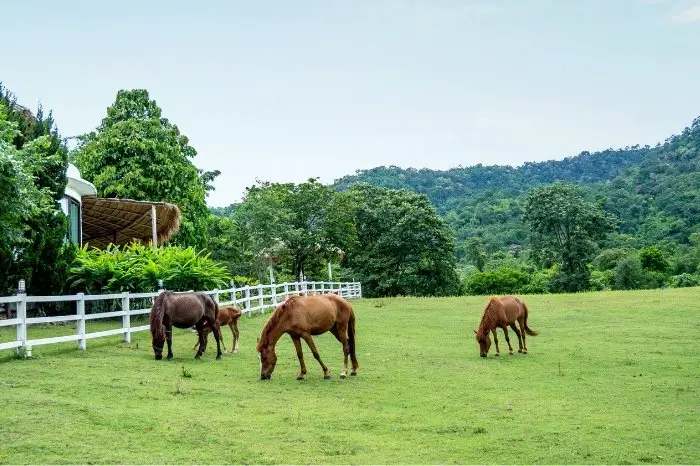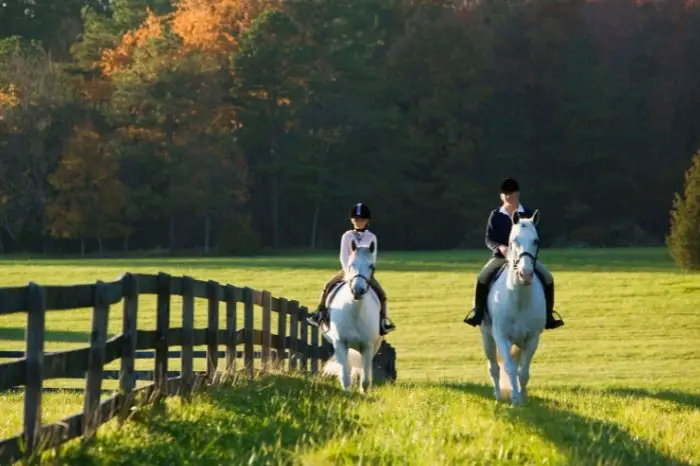Last Updated on September 22, 2021
If you have access to some grazing land, you might be wondering how many horses you can put on each acre of land. But how do you work out how many horses per acre of land? Let’s take a look at horse pasture and find how much pasture per horse is needed!
Figuring out how much grazing land horses need is not always simple. It can depend on many factors. While some horses live outside in fields all year round, others are stabled and just go out to pasture for short periods.
How Much Land Does A Horse Need?
When calculating how many horses per acre of land there are many factors that you will need to take into account. Here is what you need to think about when calculating how many acres of land per horse.

-
Type Of Horse
Some horses, such as warmbloods, may need a lot of grass to prevent them from getting too thin. Other types of horses such as cold-blooded breeds can put on weight very easily. These will not need much pasture to keep them at healthy body weight. The size of the horse will also affect how much pasture they need – small ponies eat a lot less than large horses.
-
Type Of Pasture
You might look at grassland and think it is all the same, but this is not the case! Pasture where the grass does not grow well, described as poor grazing, may not provide enough nutrition for your horse. Some pasture is very rich in lush grass, which will make your horse put on weight very easily.
-
Climate
The climate in your area will affect how well the grass grows on your pasture, as well as how much energy your horse needs. If you have long, hot, dry summers, the grass will not grow well at all. If you have cold, wet winters the land will become waterlogged or frozen, with less grass for your horse.
-
Stabling
How much pasture you need depends on how much you are planning on using it. If you plan to keep your horse outside all year round, you will need enough grazing to provide most of the food they require. You can manage with less grazing if you give extra hay, but the grazing land will become damaged by overgrazing.
Horses that are stabled for part of the day or night can manage with less grazing land. This is because they will be fed hay or haylage when they are inside. The time spent out in the paddock is reduced, so they will eat less grass.
Tough 1 Easy Breathe Orange Poly/Nylon Large Horse Grazing Muzzle
-
Feed
A good way to reduce your grazing land requirements is to feed extra hay or haylage while your horses are out at pasture. You will still need to rotate the paddocks your horse grazes in, to keep the grass in the best possible condition.
If you are planning on making your own hay for your horse, you will need extra land to do this. However, this does mean that the money-saving benefits might be lost on renting extra land and hay-making equipment.
How Many Horses Per Acre Of Land?
So, as a rough guide, you can keep one horse per two acres of land – so that is half a horse per acre of land. Not many of us own half a horse, but you could realistically keep a small pony on one acre of land.
However, this does not mean you can just turn your horse out into a two-acre field and expect that there will be enough food for him all year round. To provide access to good quality grazing in all seasons, you will need to use fencing to section off the land. This allows you to rotate the areas that the horse is allowed to access.
This is necessary because horses are selective grazers. They will ignore the less palatable grasses and pick out their favorite ones instead. By rotating the areas the horse can access, you will give the grazing time to recover and grow.
Grass also grows at different rates according to the time of year. In the spring you may need to limit the amount of quick-growing grass your horse can access. Otherwise, it is very likely that your horse will eating too much and become overweight.
In the winter, grass grows slowly or not at all. If the ground is wet or frozen the grass will also be damaged by your horse’s hooves. It is very easy for a field to become ruined by overgrazing in the winter.
How Many Acres Does A Horse Need If Stabled?
For horses that are stabled, daily access to grazing land is essential for their mental and physical wellbeing. Time spent out at grass allows them to express their natural grazing behavior. They also get to eat their favorite foodstuff – grass!
If your horse is kept stabled for most of the day, you will not need a lot of grazing land. It may be that as little as a quarter of an acre is sufficient for an hour or two spent grazing each day.
However, remember that an area this small does not allow you to rest or rotate the land. Aim for two small paddocks if possible, so your horse always has some good grazing land to relax and graze in.
How Much Space Does A Horse Need To Exercise?
If a horse is kept stabled, it must be given the opportunity to exercise every day. This could take the form of ridden exercise, or you may want to allow your horse to run and play without a rider.

For your horse to fully stretch his legs, he will need a minimum of a tenth of an acre to exercise in. This could be a small paddock, or you might have access to an all-weather surface such as an indoor arena.
Summary
So, as we’ve learned, you could keep one horse per every two acres of land if they live outside all year round. The number of acres a horse needs varies between different breeds and types of horses. The best type of grazing land for horses contains mixed grasses, herbs, and plants.
We’d love to hear about your experiences – do you struggle to find enough acres of land for your horse? Or maybe you have a question about horse pasture? Add a comment below this post and we’ll get back to you!

Kate Chalmers is a qualified veterinary nurse who has specialized in horse care for the vast majority of her career. She has been around horses since she was a child, starting out riding ponies and helping out at the local stables before going on to college to study Horse Care & Management. She has backed and trained many horses during her lifetime and competed in various equestrian sports at different levels.
After Kate qualified as a veterinary nurse, she provided nursing care to the patients of a large equine veterinary hospital for many years. She then went on to teach horse care and veterinary nursing at one of the top colleges in the country. This has led to an in-depth knowledge of the care needs of horses and their various medical ailments, as well as a life-long passion for educating horse owners on how to provide the best possible care for their four-legged friends.
Kate Chalmers BSc (Hons) CVN, Dip AVN (Equine) Dip HE CVN EVN VN A1 PGCE

